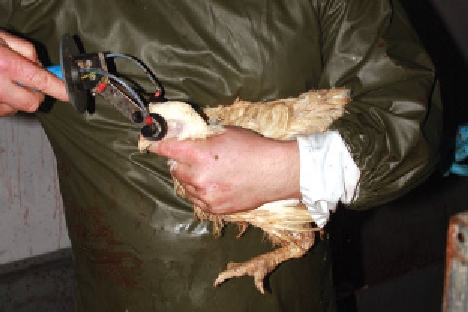Agriculture Reference
In-Depth Information
inducing insensibility. The technique has been criticised
since animals slaughtered in this way show a photomotor
reflex considered by some experts to be indicative of a
state of sensibility (Lumb and Jones, 1973).
In the Arctic,
reindeer
are killed by a curved single-
edged knife which after being inserted into the occipito-
atlantal space, is directed forwards to destroy the brain.
In India and in the Far East, practically all animals are
slaughtered while conscious. In India, the majority of
sheep and goats are killed by a method in which the
throat is cut transversely as in the Jewish method of
slaughter. The Sikh or Jakta method is also practised,
the sheep or goat being decapitated by one stroke of a
special sword.
Figure 7.8
Handheld electrical stunning of poultry.
slaughter of poultry (see also Ch. 10)
With poultry, the speed of operations, which may be
typically 6000 birds/hour, complicates the stunning pro-
cedure, as it does all other procedures. Indeed
the require-
ment for speed is a major factor in reducing the standard
of all operations in modern slaughter and processing plants
for all species of animals
.
With all stunning methods used for poultry, it is
important that both common carotid arteries are severed
by the bleeding system, whether automated or manual,
in order to ensure that birds to not regain consciousness.
Gregory and Wilkins (1989a) demonstrated that cutting
all the major blood vessels in the necks of electrically
stunned chickens resulted in loss of blood amounting
to 2% of body weight in less than 25 seconds after neck
cutting.
turkeys, respectively, when using a handheld head-only
constant voltage stunner (110 V) supplied with a fre-
quency of 50 Hz AC. Neck cutting should be carried out,
incising both carotids, within 15 seconds from the end of
the stun. If a variable-voltage, constant-current stunner
delivering sine wave AC, with low impedance electrodes
is used, minimum average currents of 100 mA/50 Hz,
150 mA/400 Hz or 200 mA/1500 Hz are recommended
and applied for a minimum of 1 second.
For ducks, a constant current of not less than
600 mA/50 Hz, applied for 4 seconds, is recommended.
Manually operated stunning devices are only suitable
for low rates of kill - up to 300 birds/hour. Assessment of
the effectiveness of stunning with handheld electrodes
can be difficult. This is particularly the case with ducks
and geese where the birds may be confined in cones. An
initial period of wing flapping and leg flexion on induc-
tion is followed by a distinct tonic seizure with stiffening
and arching of the neck, rigidly extended legs, wings
folded tightly around the breast and constant body
movements. It is important to emphasise that correctly
stunned birds can maintain a nictitating membrane and
other eye reflexes.
Electric water baths
can be used for both stunning and
killing poultry. The method requires the hanging of birds
upside down, their legs having been placed in a metal
shackle specifically designed for the particular species
and type of bird. The shackling procedure causes birds
significant distress; wing flapping is normal and, under
commercial line speeds of 6 000-10 000/hour, disloca-
tions and fractures do occur. Birds are transferred in the
inverted position to the water bath. Their heads pass
through the electrified water, and the current passes
through the whole body towards the shackle, stunning
or killing the bird. It is imperative that birds cease flap-
ping prior to the water bath or they may receive pre-stun
electrical shocks which are thought to be extremely
painful and distressing for them. This is a particular
Electrical stunning of poultry
Several types of electrical stunning device are utilised for
poultry depending on the processing speed.
Handheld head-only stunning devices
must be of a
design suitable for the species of bird to be stunned.
Electrodes vary in size, in the surface area in contact
with the head of the bird, in the impedance of the elec-
trode and in the pressure which can be applied to the
bird's head. In addition the nature of the current, whether
pulsed direct current (DC) or sine wave AC, the fre-
quency of the current and its waveform significantly
alter the time/voltage combination required to deliver
the current which will result in an effective stun. As an
example of this, the voltage necessary to deliver a fixed
amount of current at a given resistance seems to be
higher with a pulsed DC than sine wave AC and it also
increases with increasing frequency (Fig. 7.8).
Given these difficulties, it has been recommended that
a minimum average current of 240 and 400 mA should
be applied for a minimum of 7 seconds to chickens and

